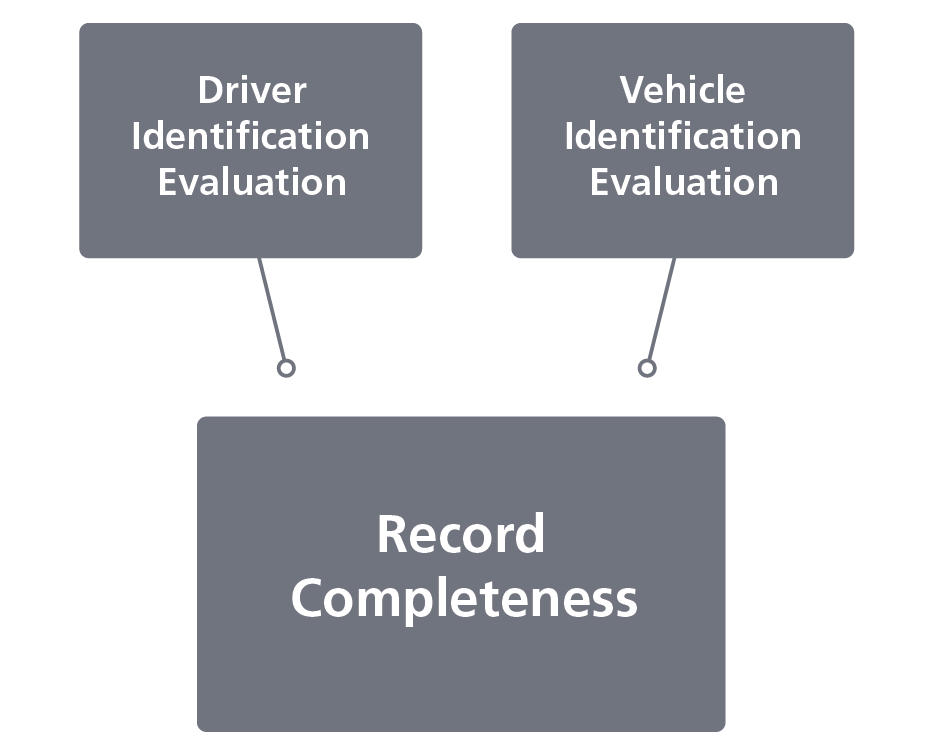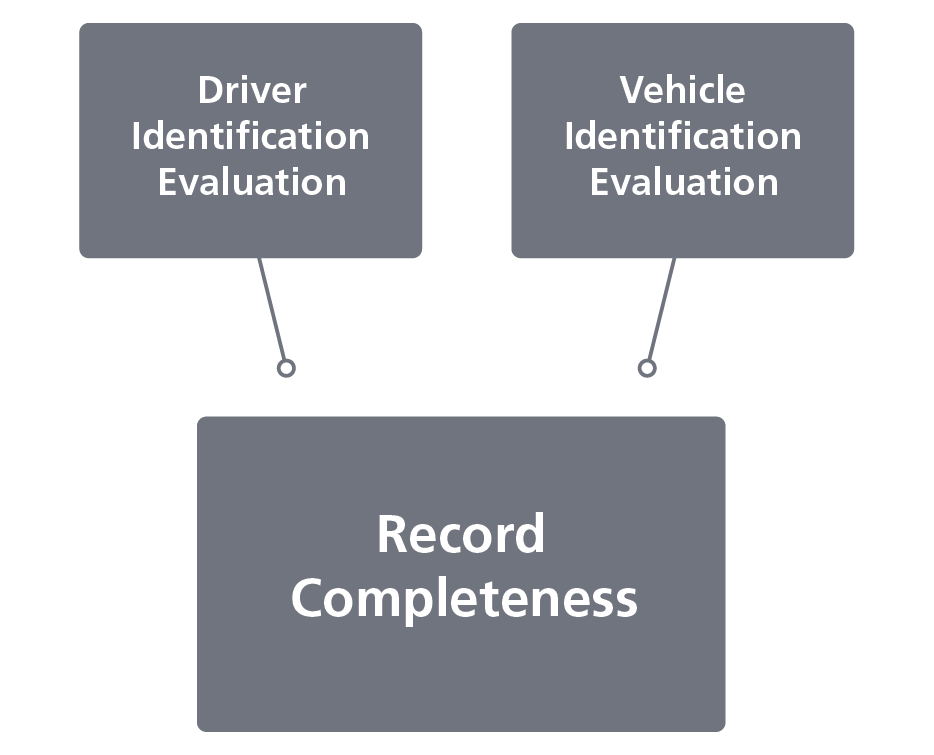Evaluated crash and inspection records fall within the 12-month time period, based on the first upload date. The quality of
this data is evaluated with each monthly snapshot and the States receive ratings of 'Good', 'Fair', or 'Poor' for nine SSDQ Measures.
These individual measure ratings, plus the Overriding Indicator, result in an Overall State Rating for each State. The methodology used to determine these
ratings is provided below.
Crash Record Completeness: Average of Driver and Vehicle Identification Completeness Evaluations
The Crash Record Completeness Measure evaluates fatal and non-fatal crash records representing interstate, intrastate, and non-motor carriers, and includes
large trucks and buses. This measure determines a rating based on the completeness of driver and vehicle crash data reported to FMCSA. A State's rating is
determined by evaluating the completeness of driver information and vehicle information separately and then averaging these results together. The
completeness of driver information is determined by the Driver Identification Completeness Evaluation and the completeness of vehicle information
is determined by the Vehicle Identification Completeness Evaluation.

The Crash Record Completeness rating is determined as follows:
| Rating |
Criteria |
Good |
Percentage of completed driver and vehicle information is 90 - 100% |
Fair |
Percentage of completed driver and vehicle information is 80 - 89% |
Poor |
Percentage of completed driver and vehicle information is 0 - 79% |
Insufficient Data |
State has less than 15 records reported in current timeframe AND percentage of completed driver and vehicle information is 0 - 79% |
Crash VIN Accuracy: Percentage of Valid Vehicle Identification Numbers Reported
The Crash VIN Accuracy measure evaluates crash records for interstate and intrastate carriers, including large trucks and buses. This measure determines
a rating based on the completeness and accuracy of the vehicle identification number reported for the vehicle involved in the crash. A State’s rating is
determined by evaluating the 17-character VIN using the 'checksum' digit in the 9th character position. The checksum digit is used to determine if the VIN
is accurate based upon an algorithm that uses the other 16 characters in the VIN. Any VIN with invalid characters (i.e. I, O, or Q) or an incomplete field
(i.e. less than 17 characters) does not pass the checksum algorithm and is invalid. Records with all the same numbers (i.e. 99999999999999999)
are also invalid. The measure does not evaluate glider kit VINS published
by a small number of manufacturers because they use prohibited characters.
Such VINs will not properly validate and cannot be fixed. Glider kits are essentially
a brand new truck with everything included (body, axles, frame, etc.) except for the engine.
The Crash VIN Accuracy rating is determined as follows:
| Rating |
Criteria |
Good |
Percentage of completed and accurate VIN is 90 - 100% |
Fair |
Percentage of completed and accurate VIN is 80 - 89% |
Poor |
Percentage of completed and accurate VIN is 0 - 79% |
Crash Consistency †: Percentage of State-Reported Non-Fatal Crash Records
The Crash Consistency Overriding Indicator evaluates non-fatal crash records representing interstate, intrastate, and non-motor carriers, and includes large trucks and buses.
This 'red flag' indicates States that have reported less than 50% of non-fatal crash records for the current 12-month period compared to the previous 3-year reporting average.
The current evaluation period selects records based on their original upload date. However, the 3-year reporting average selects records based on event date. This difference in the selection criteria more directly reflects baseline crash volume trends over time.
The Crash Consistency Overriding Indicator 'flag' is determined as follows:
| Rating |
Criteria |
| No Flag |
Estimate Reported is greater than or equal to 50% |
Red Flag |
Estimate Reported is 0 - 49% |
Insufficient Data |
State has less than 15 records reported in current timeframe AND
State has less than 15 records reported in previous 3-year average AND Estimate Reported is 0 - 49% |
† States that have an obvious and significant decline in crash record reporting will be categorized as Poor in the Overall State Rating and Crash Rating, without regard to their rating on other measures.
Inspection Record Completeness: Average of Driver and Vehicle Identification Completeness Evaluations
The Inspection Record Completeness Measure evaluates level 1, 2, and 3 roadside inspection records representing
interstate and intrastate carriers, and includes large trucks and buses. This measure determines a rating based
on the completeness of driver and vehicle inspection data reported to FMCSA. A State's rating is determined by
evaluating the completeness of the driver information and vehicle information separately and then averaging these
results together. The completeness of four (4) driver data elements are determined by the Driver Identification
Completeness Evaluation and the completeness of two (2) vehicle data elements are determined by the Vehicle
Identification Completeness Evaluation.

The Inspection Record Completeness rating is determined as follows:
| Rating |
Criteria |
Good |
Percentage of completed driver and vehicle information is 95 - 100% |
Fair |
Percentage of completed driver and vehicle information is 85 - 94% |
Poor |
Percentage of completed driver and vehicle information is 0 - 84% |
Inspection VIN Accuracy: Percentage of Valid Vehicle Identification Numbers Reported on the First Vehicle Unit within Inspection Records
The Inspection VIN Accuracy Measure evaluates level 1-6 roadside inspection records representing interstate and intrastate carriers, and includes large
trucks and buses. This measure determines a rating based on the completeness and accuracy of the vehicle identification number reported on the first
vehicle unit reported to FMCSA – all trailing units are excluded from this measure. A State’s rating is determined by evaluating the 17-character VIN
using the "checksum" digit in the 9th character position. The checksum digit is used to determine if the VIN is accurate based upon an algorithm that uses
the other 16 characters in the VIN. Any VIN with invalid characters (i.e. I, O, or Q) or an incomplete field (i.e. less than 17 characters) does not pass the
checksum algorithm and is invalid. For this measure, records with all the same numbers (i.e. 99999999999999999) are also counted as invalid.
The measure does not evaluate glider kit VINS published by a small number of manufacturers because they use prohibited characters.
Such VINs will not properly validate and cannot be fixed. Glider kits are essentially a brand new truck with everything included (body, axles, frame, etc.)
except for the engine.
The Inspection VIN Accuracy rating is determined as follows:
| Rating |
Criteria |
Good |
Percentage of completed and accurate VIN is 95 - 100% |
Fair |
Percentage of completed and accurate VIN is 85 - 94% |
Poor |
Percentage of completed and accurate VIN is 0 - 84% |
Inspection Timeliness: Percentage of Inspection Records Reported within 7 Days
The Inspection Timeliness Measure evaluates inspection records representing interstate and intrastate carriers, and includes large trucks and buses. This measure determines a rating based on the percentage of inspection records reported to FMCSA within 7 days during a 12-month period.
The Inspection Timeliness rating is determined as follows:
| Rating |
Criteria |
Good |
Percentage reported within 7 Days is 85 - 100% |
Fair |
Percentage reported within 7 Days is 65 - 84% |
Poor |
Percentage reported within 7 Days is 0 - 64% |
Inspection Accuracy: Percentage of Matched Inspection Records
The Inspection Accuracy Measure evaluates inspection records representing interstate carriers and intrastate carriers transporting hazardous material, and includes large trucks and buses. This measure determines a rating based on the percentage of inspection records reported by the States during a 12-month period that were matched to a company registered in MCMIS.
The Inspection Accuracy rating is determined as follows:
| Rating |
Criteria |
Good |
Percentage of matched records is 98 - 100% |
Fair |
Percentage of matched records is 90 - 97% |
Poor |
Percentage of matched records is 0 - 89% |